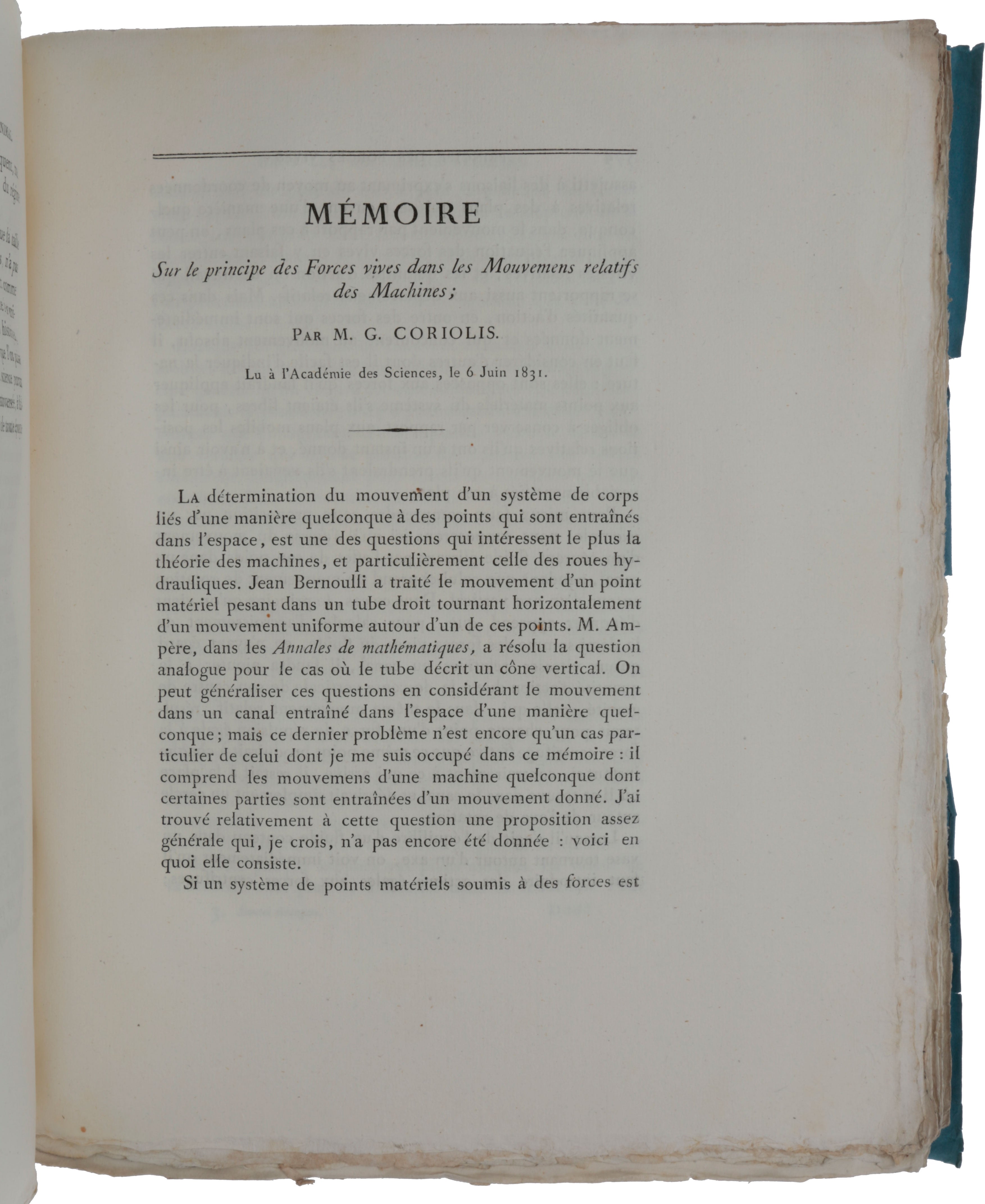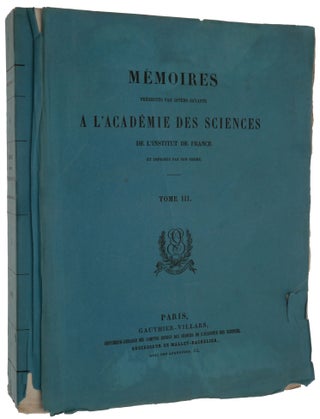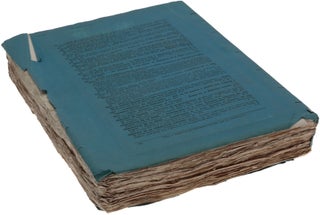‘Sur le principe des forces vives dans les mouvemens relatifs des machines,’ pp. 573-607 in: Mémoires présentées par divers Savants à l’Académie des Sciences de l’Institut de France, Tome III.
Paris: Gauthier-Villars, 1832. First edition, complete journal volume in original printed wrappers, of this important work on the theory of machines, a follow-up to his Du calcul de l’effet des machines, published in 1829 (but begun a decade earlier) in which he studied dynamical problems associated with rotating machinery. “His approach differs substantially from the usual Newtonian mechanics method used in the eighteenth century and is also quite different from the general mechanics of the nineteenth century” (Oliveira, p. 2). This paper introduced the new notion at that time of ‘inertial forces’ (forces d’entraînement), and also contains the calculational basis for a sequel published in 1835 in which Coriolis introduced the famous ‘Coriolis force’ (‘Sur les Équations du Mouvement Relatif des Systèmes des Corps’, Journal de l’École Polytechnique 15, pp. 142-154). But the main object of the paper is to relate the kinetic energy (forces vives) of a machine when viewed from two different inertial reference frames. He describes his result as follows: “The equation of the live forces can be applied by entering the relative speeds, and the amounts of action or of work that also relate to relative motions. But in these amounts of action, also, forces that are immediately given and that contribute at the absolute moment, others must be considered whose nature is easy to indicate: they are opposite the forces that ought to be applied to the material points of the system if they were free, to force them to conserve compared to the moving planes the relative positions that they have at some given point … it would be a mistake if the proposal was regarded as obvious, even in this fairly simple example. It is so unobvious that these forces must be introduced that we would arrive at false results if we were to proceed with issues other than that of the live forces” (translation from http://bibnum.education.fr/sites/default/files/analyse-coriolis-force-en.pdf). One copy (offprint) listed on ABPC/RBH. “In 1829 Coriolis published his first book, Du calcul de l’effet des machines, begun ten years earlier and inspired by the writings of Lazare Carnot … While many scientists seemed to favor a radical separation of theory from technology, Coriolis voiced the belief that rational mechanics should be developed as a discipline for the enunciation of general principles applicable to the operation of motors and analysis of the functioning of machinery. The changes in terminology that he proposed, largely as a result of his teaching experience, were in fact conformable to this clearly conceived policy, as they were to the requirements of the theory itself. “The first of these changes consisted in abandoning for the term ‘force-displacement’ the ambiguous designations of mechanical power, quantity of action, and dynamic effect, in all of which was subsumed the consideration that processes occurred in time. The word ‘work’ was in the air following the publication in 1821 of the treatise in which Coulomb had attempted with reference to the limited capacity for activity in men and animals to characterize the notion of the consumption of something in overcoming resistance. The French word—travail—conveys the idea particularly well, and it was certainly Coriolis’ contribution to assign it a technical meaning and thereby clarify a notion as old as mechanics itself … “The second important innovation made by Coriolis was to apply the term force vive (kinetic energy) to one-half the product mV2. This was a simple matter of coefficient but convenient in the formulation of the general equations of dynamics. Coriolis thus expressed the principle of vis viva as the ‘principle of the transmission of work.’ By development of the applications inherent in this change of viewpoint, Coriolis’ ‘small contribution’ marked an important step in the realization of his comprehensive theory. “Coriolis did not delay in producing more. Indeed, he had been led to study the work of internal forces in a material system in order to determine under what conditions this work is nil; he thus discovered the very remarkable characteristic that the value of the work done by a system of forces of which the resultant is equal to zero is independent of the frame of reference with respect to which the changes of position are considered. Wishing to evaluate the work done by fluids in hydraulic machines and steam engines, he found simple expressions that apply to the fixed framework of the machine with respect to which the moving parts are in motion. It was therefore natural that the question of relative motions in machines should occur to Coriolis and that it should entail study of the effects of changes in the system of reference on the fundamental equations of analytical mechanics. But he confined himself at first to the simple problem of comparing two systems of reference in rectilinear translation moving uniformly in respect to each other, for which the work done by inertial forces is identical. On 6 June 1831 Coriolis submitted a memoir to the Academy on the problem of the general case [the offered paper]. He envisaged it in a highly characteristic fashion; to the extent that consideration of relative motion in machines was unavoidable either to eliminate or to simplify the work of linking forces, theory has necessarily to deal with the question of inertial forces when the system of reference is changed. “Thus for the first time Coriolis entered into the study of acceleration in composite motions, and the various phases of this study’s formalization deserve attention. “In his 1831 paper, Coriolis had limited himself to exhibiting the existence of a term complementary to relative acceleration and to acceleration of the drive. Since his explicit aim was to enrich rational mechanics with a new statement concerning the transmission of work in relative motion, he was satisfied to demonstrate by computation—without interpreting the analytical expressions for complementary acceleration—that the work of connecting inertial forces is nil for real relative displacements; the problem of interpreting this result without calculations disappeared in the result itself. “From the two theorems on the transmission of work—one for absolute motion, the other for relative motion—Coriolis easily deduced the difference in the case of hydraulic wheels in the work absorbed by the frame of the machine. He could feel satisfied to have removed certain of the doubts expressed about the possibility of subjecting these machines to theory. “Poisson’s report to the Academy did Coriolis the service of observing that the considerations that had animated him should be studied in greater generality. The memoirs that Coriolis submitted to the Academy after 1833 insured this generality in considering material systems as combinations of molecules with various kinds of connections” (DSB). Coriolis’ paper was published simultaneously in the Journal de l’École Polytechnique. Coriolis was born in Paris on 21 May 1792 to a small aristocratic family that had been impoverished by the French Revolution. The young Coriolis showed remarkable mathematical talents at an early age. At 16 he was admitted to the Polytechnic School where he later became a teacher. During the 1830 Revolution Augustin-Louis Cauchy (1789-1857) left France for a period and Coriolis was invited to take his place. In 1832 he became associate professor with Navier at École des Ponts et Chaussées. In 1838 he became director of the Polytechnic School, succeeding Pierre Louis Dulong (1785-1838) and accumulated teaching and research activities. Coriolis died in 1843 at the age of 51 in Paris. Oliveira, ‘Coriolis’ Theory of Machines and Mechanisms,’ Proceedings of the 13th World Congress in Mechanism and Machine Science, 2011, pp. 1-5.
4to (273 x 224 mm), Original printed wrappers, uncut (front wrapper creased and with small tears and a little loss).
Item #5019
Price: $2,000.00




